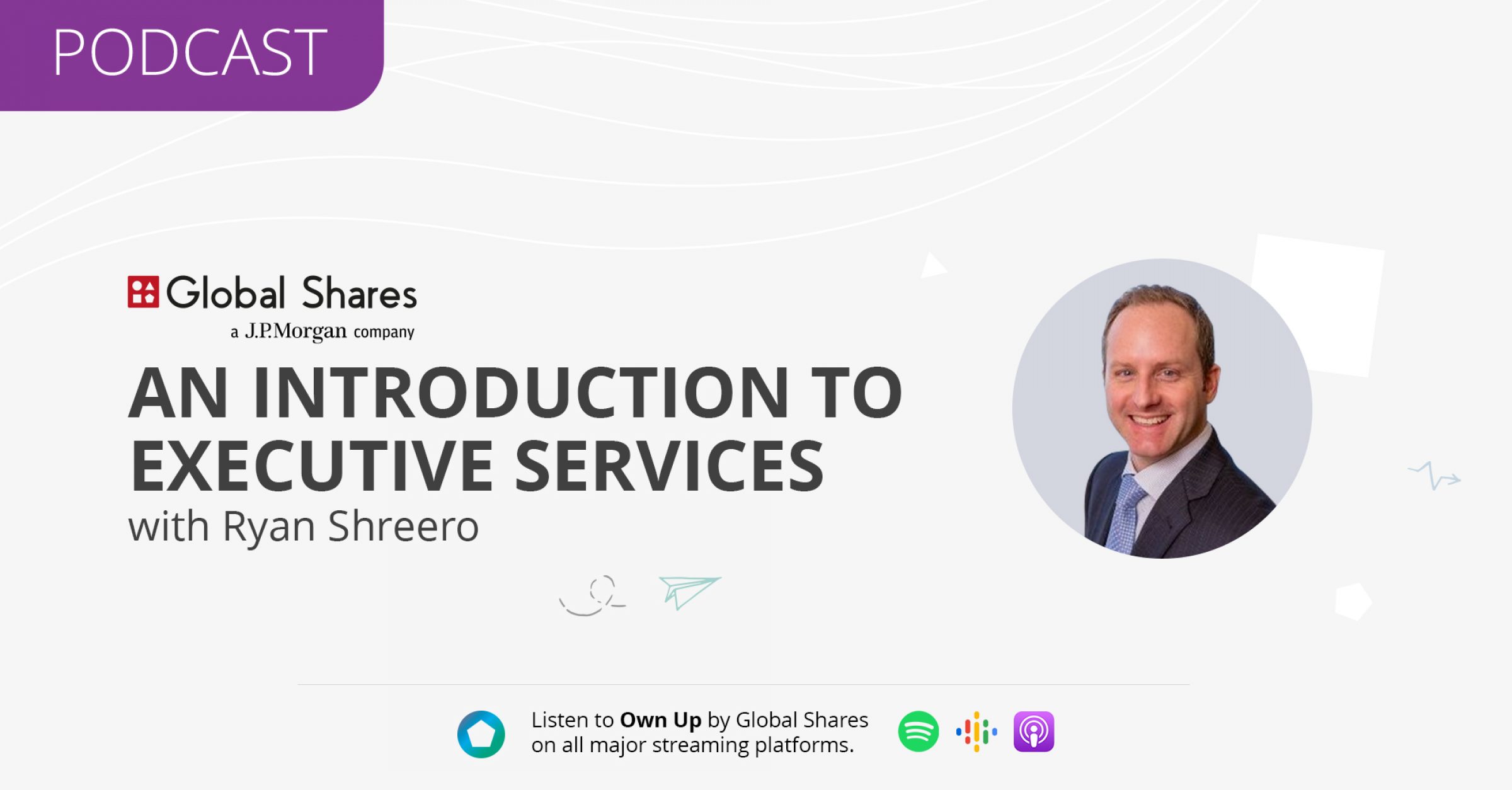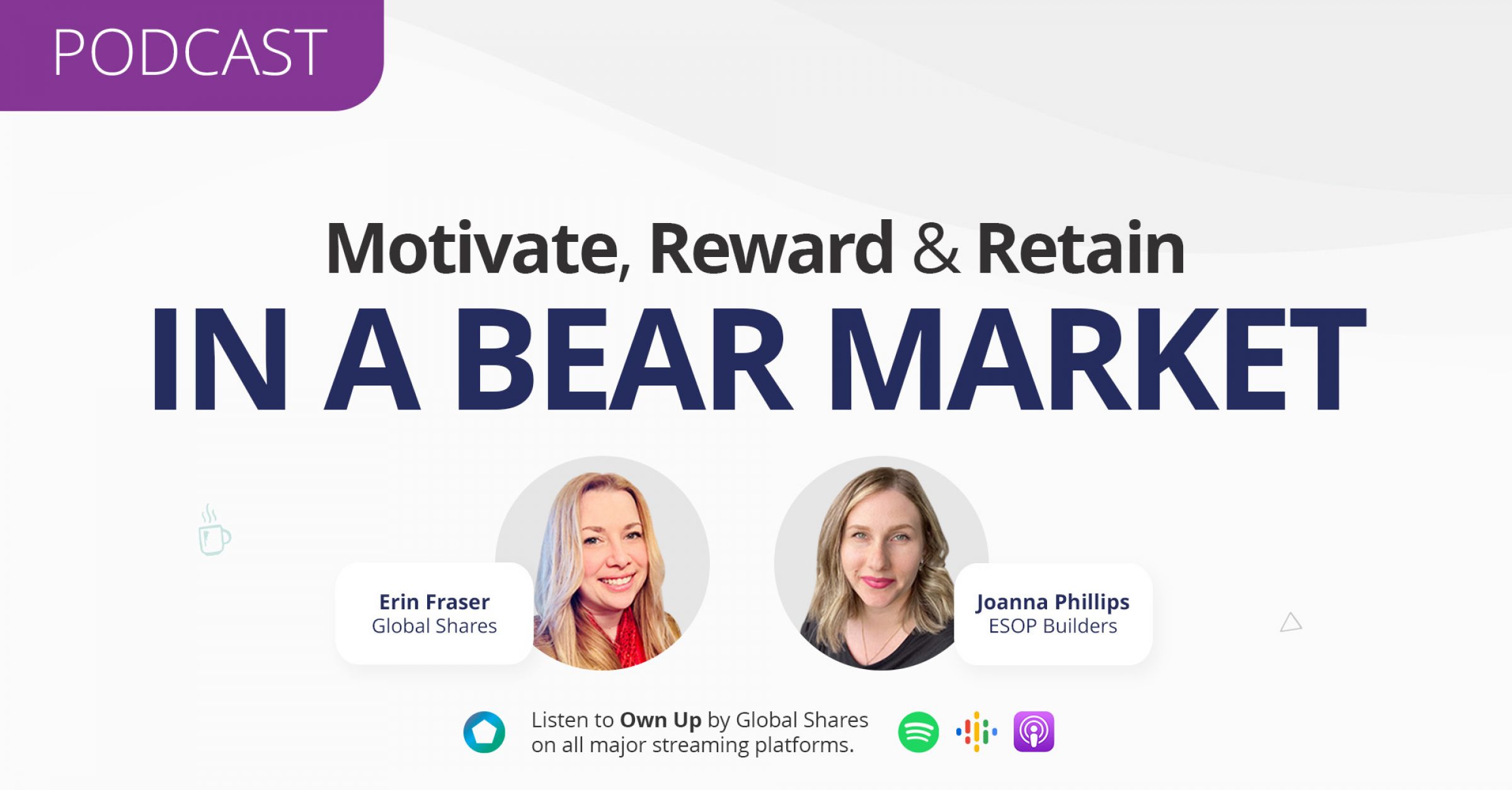Extending an equity compensation package to executives in any company does not end with simply signing over shares. There are considerations such as insider trading liabilities, the handling of material non-public information and protecting against negative reputational damage that need to be taken into account. With strict regulation to be followed, for HR departments and Rewards & Benefits teams it is a complex situation, one that needs to be managed correctly.
Taking a look at the rules surrounding these topics and giving an introduction into the world of Executive Services, Ryan Shreero, Executive Director of Executive Services at JP Morgan, joins regular hosts and Global Shares colleagues Chris Dohrmann, SVP of Strategic Partnerships and John Bagdonas SVP of Business Development, to discuss:
● The biggest challenges faced by executives today
● Using 10b5-1 plans
● Financial education for informed populations
● Incorporating personal executive goals
● Changing circumstances and options for amending an existing plan

Ep15: An Introduction to Executive Services, 10b5-1 and protecting against Insider Trading with Ryan Shreero
Read full transcript
00:00
This is Own Up, the Global Shares podcast about employee ownership and equity compensation. Answering questions and sharing with industry experts, here are your hosts, Chris Dohrmann and John Bagdonas.
Chris Dohrmann 00:21
Welcome back to Own Up the Global Shares podcast all about employee ownership and equity compensation. I’m your host, Chris Dohrmann, and I’m joined by my friend John Bagdonas.
John Bagdonas 00:31
Hi, Chris.
Chris Dohrmann 00:32
Hi, John!
In today’s episode, we’re delving into the world of executive services, providing insights and exploring the evolving trends that can supercharge your career in the c suite. What exactly are executive services, and why are they integral to the success of high level executives, we’ll discuss today! So joining us today is Executive Director of Executive Services at JP Morgan, Ryan Shreero, a seasoned professional in executive services. Ryan, you’re welcome to the podcast.
Ryan Shreero 01:01
Thanks so much, Chris. Happy to be here!
Chris Dohrmann 01:03
Tell us about yourself and the work that you do in executive services. Both you and I are acquainted as well as John but I’d love the audience to hear more about your background.
Ryan Shreero 01:12
Yeah, appreciate it. So I, you know, I come to JPMorgan after 18 years, all in executive services from Oppenheimer & Company, joined JP Morgan, as a, you know, exciting new role as we incorporate both executive services with a stock plan administration offering being Global Shares, which really just makes our executive services offering that much better. The idea behind it is to have more of a one stop shop where participants that are, you know, trading their equity, their company equity, have a participant portal to do that, but also have the full power of JP Morgan’s private bank to guide them through what is executive services, which is really Chris, focused around Rule 10b5-1 and the setting up and trading of scheduled trading plans.
Chris Dohrmann 02:07
Great, thanks, Ryan! And so you’ve defined it, which is really something that, that’s the first step. Most folks aren’t familiar with the complexity surrounding what executives have to go through when they’re trying to trade company equity. So what are the current challenges? What are the biggest challenges faced by executives today?
Ryan Shreero 02:27
Yeah, so you know, I’d say the number one and most important thing that we focus on is insider trading liability. So anybody that is within a company, and in the c suite, they’re subject to or privy to what’s called material non-public information, which makes it unfair to the rest of the world as far as trading goes. So they have a lot of rules surrounding that. And those rules are really, you know, only having a couple of open trading windows per year. And those trading windows are around when the companies, you know, release their earnings and everything becomes public. At that point in time, they have a window that will open up and they can put a trading plan in place at that time, and in that time only, and in good faith and without any material non-public information. And we help guide them through that. There’s also a lot of other rules that go hand in hand with that, as far as reporting goes and filing with both the exchange, and the SEC that we help guide them through as well.
John Bagdonas 03:32
Just a quick question, Ryan, in your experience, it’s about 10b5-1 plans, how many companies, on average, from a percentage standpoint require their insiders or their executives to utilize a 10b5-1 plan as compared to ones that maybe strongly recommend it, but don’t necessarily require it? What’s your experience in that?
Ryan Shreero 03:52
Yeah, that’s a great question John. In my experience well over 50% of companies out there require it and I would say another 48% of them strongly recommend it. This is something that really falls into the corporate governance space and they, you know, companies really need to have controls in place. Every company that issues equity to employees, and officers, of course, will have an insider trading policy and this will be part of that insider trading policy, either a strong recommendation or a mandatory, you know, 10b5-1 program in place. Additionally, what makes it a little easier for the company, on that note is to not have too many of them in place at one time, meaning do we have seven different, do we have 10b5-1 plans at seven different broker dealers with seven different contracts that we all have to have outside counsel review and things like that? Companies have always found that having, you know, one or two providers to focus on this has really been the best way to do it from a risk control perspective, from a reporting perspective, and, you know, it’s just, frankly, less error prone.
John Bagdonas 05:07
You and I know that it’s definitely a trend for at least for some companies where they don’t have any choice that is basically a directed broker, they have to go through a specific broker for the 10b5-1 plans.
Ryan Shreero 05:18
Correct! Yeah, there’s a lot of companies that are out there that are like that, it gets a little trickier for the directors of the company, because they’ll have, you know, they’re not technically officers of the company, even though they’re directors, they sit on the board. There is, you know, some flexibility when it comes to the directors but in an effort to make everyone’s lives easier, including those directors, including, especially those folks at the company that are having to do all the reporting, most will require to be in one place and in one place only. So, you know, we actively go after, here at JP Morgan and in coordination with Global Shares, we actively go after that sort of captive broker strategy, and really try to partner with our companies to capture all those 10b5-1s and make it a seamless experience for both those officers and the employees in the company that are administering the plan.
Chris Dohrmann 06:10
So just to summarize what we’ve been discussing so far, the 10b5-1 plan, and that’s nomenclature, right, from the SEC guide, is really a proactive defense for both the corporation and the executive against allegations of insider trading, correct?
Ryan Shreero 06:27
Yes, that’s 100% correct Chris. So it’s a defense against the allegations of insider trading. That’s the key benefit. That’s the main focus that we’re, you know, we’re working with on this. And that’s the, really from both the company and the participant or officer of the company in this in the sense, from their perspective, that’s the number one most important thing, it does have a few other key benefits as well. One being, you know, really minimizing the negative media perception around selling as an insider, you know, as you guys may well know, and for the audience, anytime you’re in a situation where you’re an officer of a company, and you make a sale of stock, that becomes public information. So both, you know, an intent to sell and an actual change of beneficial ownership forms get filed with both the exchange and the SEC and it becomes public information. And now, you know, investors and shareholders and, you know, everyone that pays attention to the news is wondering, you know, why is this person selling? Is there something wrong with the company? You know, when you’re selling pursuant to a 10b5-1 trading plan, you know, it really minimizes the effect of that, because people can look, and they see in the disclosure, that it was done pursuant to a trading plan, that it’s more of a scheduled sale, and it’s more of a planned process, not a oh no, I want to dump my stock type of situation, which is really good.
One more thought on that too Chris is, it’s you know, on the scheduled sale front, it is just that right? You open, your window period does open, you put the plan in place, you know, you have a cooling off period, which is now all the way at 90 days, then the plans can start to trade. They trade pursuant to that plan on a schedule, so that you provide some flexibility to that officer of the company as well. So they’re in a situation where instead of waiting for the next open window period, and oh, I’m going into this next open window period, but I have a FDA trial, and guess what the window is not going to open for me because I know what went into that, and you know, I’m not going to have the opportunity to put a plan in or put a trade in during that open window period, because I have material non-public information. Instead, once the plan goes off, it can trade through blackouts, it can trade through, and what I mean by blackouts is the non-opening of a window, right, the non-trading blackout for everyone. It can trade through all of that, regardless of what information that officer has at that time because it’s the plan was set in place prior to that information. So it can provide some real trading flexibility as well.
John Bagdonas 09:13
I know Ryan, you mentioned about cooling off periods, brings up the question to mind for me, is there any guidelines or rules about minimum plan length or maximum plan length?
Ryan Shreero 09:24
You know we try to focus around a year, I would say that if your plan is six months to a year is where the real sweet spot for plan links. If you’re seeing plans over two years, I think that’s frowned upon in my experience that’s not best practice out there. What I like to do and this is what we do for our executive services clients here at JP Morgan is we’d like to have those, we’d like to have plans in a predetermined open window period, and typically put a new plan in place during that open window period so there’s consistency of trading throughout. So I think that’s, you know, one little note, I’d like to add on here, six months to a year, try to have it terminate or expire during what would be a known window, open window period. That way you can put a new plan in place right off the bat there without having to wait for both an open window and a new cooling off period.
John Bagdonas 10:24
Well, let me ask a related question, which I’m sure is probably frowned upon, but what about the prevalence of an executive having multiple concurrent plans at the same time?
Ryan Shreero 10:37
Yeah, great question. Not only frowned upon, but you know, as far as the rule changes go, you know, it’s really not something anybody is going to be doing going forward, you know, not, you can have concurrent plans, like one terminating during an open window period, another one coming into place, but you won’t have, you know, you won’t see companies allowing, and broker dealers, trading multiple plans for any officer of any company that’s been terminated.
Chris Dohrmann 11:05
So again, to summarize, I mean, we’ve been talking about this as if we, because we talk about it almost every day, but there’s a lot of jargon. So we’ve identified the role, we’ve identified things like, you know, the fact that you’re signing up for it, and the company may be imposing it, but they may be giving you some choice in the number of plans. And we’ve also defined the cooling off period. My point there is, is financial education part of this process, because it’s better to have an informed executive population signing up for this, or is that your experience?
Ryan Shreero 11:39
You know, it’s definitely my experience Chris that it’s better to have an informed population. And what we like to do is, you know, once we know we’re going to be servicing all the executives of a particular issuer from both a 10b5-1 or just open window control stock trading perspective, we like to host an education event, whether it be a zoom, or in person where we really bring them up to speed on – what is executive services? What is Rule 10b5-1? What is your own company’s insider trading policy, what are you allowed to do, what are you not allowed to do, and really help to guide them through that process, because it is cumbersome. It is, you know, again we’re in a situation here where any of these trades become public information. So we want to minimize the media effect of these trades. We also want to protect the stock price at all costs too so we help guide them too, and advise them on what goes into a plan. You try to not have large blocks of stock coming out at the market, which would have a negative impact on the share price. We try to really educate them both in a group setting and then down to the individual from a planning perspective.
A lot of these equity securities that they’re getting have different types of tax treatment, whether it be I mean, more industry nomenclature again but, whether it be incentive based stock options or non-qualified stock options, there’s a different tax treatment to both of those, restricted stock unit, vesting at ordinary income. So there’s a ton of planning that can go into this, and should go into this in an effort to really, you know, maximize the benefit of the securities. I look at it like this, I want to maximize it both for the company and for the individual. Company spend a lot of money granting equity to employees, that is the sort of, you know, the number one way to capture and retain talent these days, and we want them help them maximize that. We also want the employee, we want that to be a good experience for them. I’ve worked on cases where there’s been, you know, this kind of multi country tax treatment and situations where at the end of the grant, which was supposed to be a positive experience for the employee they ended up paying taxes in two different countries. It wasn’t that far above the strike price on the option in the first place. And it ended up being a negative experience for the employee. And I know that’s not why companies grant equity. So we want to help educate them to maximize that both from the company perspective and from the officer perspective.
Chris Dohrmann 14:35
Ryan, you’re a perfect guest because you lined up my next question. Obviously, let’s be frank, the goal of a corporation is to make an increase revenue for not only the employees and the executives but for the shareholders. But the point of trading the stock is for an individual’s financial goals and objectives. So I think the plan also needs to incorporate some of those executives goals, whether it be you know, financial planning for a future development for future generations, for succession planning, for tax planning, all of that has to come into place, is that your experience as well?
Ryan Shreero 15:16
100% There very rarely will you see a plan that just gets inputted and is just a pure function of trading. I mean, there’s a lot of thought that goes into this. And I think the higher up you get into a company, and the amount of equity you’re getting from that company, the more planning that actually goes into it. You know, we’ve been seeing this sort of firm wide blackout at issuers a lot and folks that you know, are only getting, you know, a little bit of stock each year having to put 10b5-1 plans in place. I would discourage that I think it’s much more for the 144 filer population, meaning the officers, directors, 10% shareholders, folks that really have that extra reporting responsibility, because the plans are, you know, a lot goes into them, a lot of planning work goes into them to maximize not just the experience of the participant, but again, you know, managing for impact on the stock and managing for media perception and all these other things. So, you know, I think the plans, in my experience, there’s a ton of work that goes into it, both from a tax and financial planning perspective. Then it actually comes to our desk here, with the general thoughts of what this particular participant is looking to accomplish, and we’ll craft what our thoughts would be on how to accomplish that in a plan. And we’ll have many iterations of it as it goes through back and forth with the participant and issuer council and our own counsel until we come up with a plan that really makes sense, and really achieves what they’d like. So a lot goes into it, a lot of planning, a lot of strategy. And then I would think at the 10b5-1 the actual plan itself is just a tool to accomplish that strategy.
John Bagdonas 17:13
Now, Ryan, let me ask you a planning related question, obviously, you’ve definitely stressed how important that is. But as we all know, circumstances change. And so as thoroughly or as comprehensively as someone may have planned or put thought into a 10b5-1 plan, what are the circumstances or the flexibility if need be to amend a plan? Because of, you know, things that have changed either in the person’s personal life or circumstances, or for any other reasons that they may want to amend a plan?
Ryan Shreero 17:49
Yeah, great question John. I think, you know, things do happen, right? People have events happen, people have personal things that would require them to amend or terminate a plan. I would say, since the rule changes though early in the year, we’re not really in a situation where we can really modify plans anymore. The reason being is each modification to any plan starts a new cooling off period. So we would have a situation where if let’s say you had a plan in place, we come into an open window period, which allows for new plans and for modifications at that point in time, not prior, not during a blackout, but during an open window period. We can put in an amendment to that plan or a modification to that plan. But what happens is you start a new cooling off period each and every time you do that. So essentially, John, you’re putting a new plan in place. So we don’t even look at modifications and amendments anymore to plans, we just considered them all new plans at that point in time, because you’re always per the rule, you’re starting a new plan, you’re starting a new cooling off period. So that’s what we look at, we consider that is a new plan. And then I think as far as terminations go, I want to touch on that for a second because there is no rule that states that you cannot terminate a plan, right? So you know, according the SEC, according to the rules and regs and industry best practices, a plan can terminate for any reason at any time. There’s no, a non-trade is not an enforceable action that said, you know, everybody needs to be able to sign off on this from the company side from the broker dealer side and not just the participant. So each company will vary as far as their insider trading policy goes when it comes to terminations, but sort of generally the rule is that you can terminate at any time.
John Bagdonas 19:50
But as you sort of implied, the optics of it depending on the circumstances are not necessarily the best of terminating a plan, particularly if the executive is continuing employment.
Ryan Shreero 20:01
Correct, yes! Each and every issuer will have their take on how that’s to be handled. Most require signatures across the board from both the broker dealer side, the participant side and issuer side, meaning CFO or general counsel on that side as well. So, there’s at a minimum triple sets of eyes on these but historically speaking, anybody could terminate a plan at any time.
John Bagdonas 20:32
Alright so Ryan, in your vast experience, maybe is there one or two success stories that are particularly memorable for you that you could share with us?
Ryan Shreero 20:41
Oh, sure! I mean on this executive services desk here at JP Morgan, I think the average industry experience is 25 years. I’m sort of the baby here at 18. You know, it’s a combine 150 years of experience. We’ve seen everything in every way shape or form you can imagine. Some of the things that I would point to as being very successful are companies that have, for example, may have brought ownership but it may be a circumstance where it’s thinly traded for one reason or another. What we see a lot of times is the difference between common shares, and, you know, like B shares, for example, where just the founders and some of the super senior folks at the company have those, and they’re going to convert them into common and trade. And now you have a, what was a thinly traded situation, all of a sudden have a big flood of stock hitting the market. So we will try to guide them, you know what we like to do ahead of time, we have dedicated traders that support our 10b5-1 desk, and we would have them make a market in those securities ahead of time, where they know where the buyers are, they, you know, you can’t pre-arrange a sale, and it always has to be a market transaction, but you can feel where the levels are, if you start trading in the security ahead of time, so we can kind of guide them from that perspective.
What we’re hoping to gain in every circumstance is a very orderly disposition of shares. So we would have them work ahead of time to feel where the levels are, and know where they can execute those trades. So thinly traded stocks is one thing, just the real tax planning is another I would say, and that isn’t specific to our desk, but more of the private bank and all the work that goes into planning for any of these trading plans. We’ve seen circumstances where someone was in a situation where they were exercising and selling incentive stock options same day, and really the tax planning that goes into that, if you do it properly, you can be exercised and hold for additional year, and you would have a long term capital gains treatment on that, as opposed to ordinary income. So having some proper planning going into these and not being forced to, right at the very end, oh, um, you know, I’ve had this grant, or have had these options for almost 10 years, and now I’m running up against a deadline, because they’re going to expire, being forced to exercise and sell as opposed to, prior to that, being able to exercise and hold and get the preferential tax treatment is a big deal. So I would say, you know, a lot of our success, again, 10b5-1 is really a tool to achieve it, but a lot of our success comes from the planning work that goes into this from the private bank side.
Chris Dohrmann 23:42
Ryan, John, I’d like to ask for your closing thoughts, because I want to give mine right now. Ryan, I’d love to have you back. Because you’ve mentioned a couple of times, the rule changes. And we’ve talked about the introduction of the executive services and 10b5-1 specifically. But I’d like to talk about the rule changes that have come down, because I think there are some implied changes, implied activity that’s going to come about because of those changes. And I think it’s important for folks to know, so please, if you could make time to come back, I’d love that.
Ryan Shreero 24:11
Oh, it’d be my pleasure, we could cover up all the rule changes! We could devote an entire episode to that Chris! Because we went through about a 20 year period where there was really no changes whatsoever, on the heels of moving away from 144k and changing some holding periods and things like that to 20 years of no changes whatsoever to a massive amount of changes in all. They telegraphed it, we knew it was coming. We were urging issuers to focus on it well ahead of time, but basically in one fell swoop, they made some pretty broad changes, so happy to devote some time to that and happy to, you know, cover off our interpretation of what those changes are. And I say that, because the language on those can be very vague, and it’s intentionally vague and subject to interpretation. So we will coach you up on, you know, what we think, what we’ve been advised to, from our own interpretations from counsel here.
Chris Dohrmann 25:17
And, John, I just wanted to get your opinion, because I think the fact that the 10b5-1 sounds difficult and a little complicated and a little bit overbearing, but I think we have found that people that employ the use of 10b5-1s, it’s been of benefit not only to the corporation but to the individual, the executive or the 144 reporter.
Ryan Shreero 25:40
Yeah!
John Bagdonas 25:40
Yeah! I mean, I’m sorry, go ahead, Ryan.
Ryan Shreero 25:42
Yeah I would say I almost to a fault, right, to the point where, you know, it’s such a beneficial experience, both from a planning and trading perspective that more folks want them that maybe don’t even actually need them. They just have blackouts that we need to navigate through. So, we’re happy to dive into that and advise as well. But yeah it is a cumbersome rule. And it’s a cumbersome area. That said working through it does become a net positive experience for both the issuer and the officer of the company.
John Bagdonas 26:18
And I think that’s an important point that you brought up earlier. And I think Chris touched on it as well that there’s a true cost involved, obviously, in managing and putting the plans in place. But ultimately, you want to weigh that against the risk benefit I should say probably is the best way to describe it. That if there are people that are just using them for the sake of the fact that well, you know, the senior people in the organization are so I should too, where you’re not necessarily going to be subjected to the same, or have a need for an affirmative defence with something that’s very ordinary, from a transactional standpoint, that you’re expending this cost and effort to put a plan in place or a 10b5-1 for someone where it doesn’t necessarily apply in terms of what the true risk benefit profile is for that individual.
Ryan Shreero 27:09
Totally agree. There are other ways to achieve that. You know, I know for example, working with Global Shares, our clients that are both, you know, 10b5-1 clients with the private bank, and also Global Shares clients where, you know, Global Shares is their stock plan administrator. I know that Global Shares has the capability of turning off trading at any point in time to sort of enforce those, or the company’s allowed to through the Global Shares website, turn off trading to enforce those blackouts and then turn them back on when everything’s good to go! That 9 times out of 10 for folks that don’t have that extra you know, filing and reporting and preclearance process that 9 times out of 10 will satisfy perfectly for those folks. And then you know, we’ll focus on the reporting and filing requirements for the folks that are in contact with material non-public information.
Chris Dohrmann 28:08
A huge thank you to our guest, Executive Director of Executive Services at JP Morgan, Ryan Shreero. It’s been great talking to you!
Ryan Shreero 28:16
Thanks Chris!
Chris Dohrmann 28:18
Thanks for listening to Own Up by Global Shares. If you found this exploration of executive services enlightening, be sure to subscribe and share with your peers! Until next time, at least for now, from me, Chris Dohrmann…
John Bagdonas 28:30
And me, John Bagdonas!
Chris Dohrmann 28:33
Thanks for listening and take care!
28:35
The Own Up podcast is brought to you by globalshares.com. To get the inside track on employee ownership and equity compensation, click follow on your podcast player right now so you get the next episode automatically. Information provided in this podcast is intended for informational and educational purposes only. It may contain views which differ from the views of JPMorgan Chase & Co. For specific guidance on how this information should be applied to your situation, you should consult a qualified professional. For full details see the show notes on your podcast player right now. The Own Up podcast is produced by dustpod.io for globalshares.com
Information provided in this podcast is intended for informational and educational purposes only. Guests on the Own Up podcast may not be affiliated with JP Morgan Chase & Co. The podcast contains the views of a JP Morgan employee, which may differ from the views of JP Morgan Chase & Co., its affiliates and employees. The views and strategies described may not be appropriate for everyone. Certain information was obtained from sources we believe are reliable, but we cannot verify the accuracy of the content and we accept no responsibility for any direct or consequential losses arising from its use. You should carefully consider your needs and objectives before making any decisions. For specific guidance on how this information should be applied to your situation, you should consult a qualified professional.
Please Note: This publication contains general information only and Global Shares is not, through this article, issuing any advice, be it legal, financial, tax-related, business-related, professional or other. The Global Shares Academy is not a substitute for professional advice and should not be used as such. Global Shares does not assume any liability for reliance on the information provided herein.







